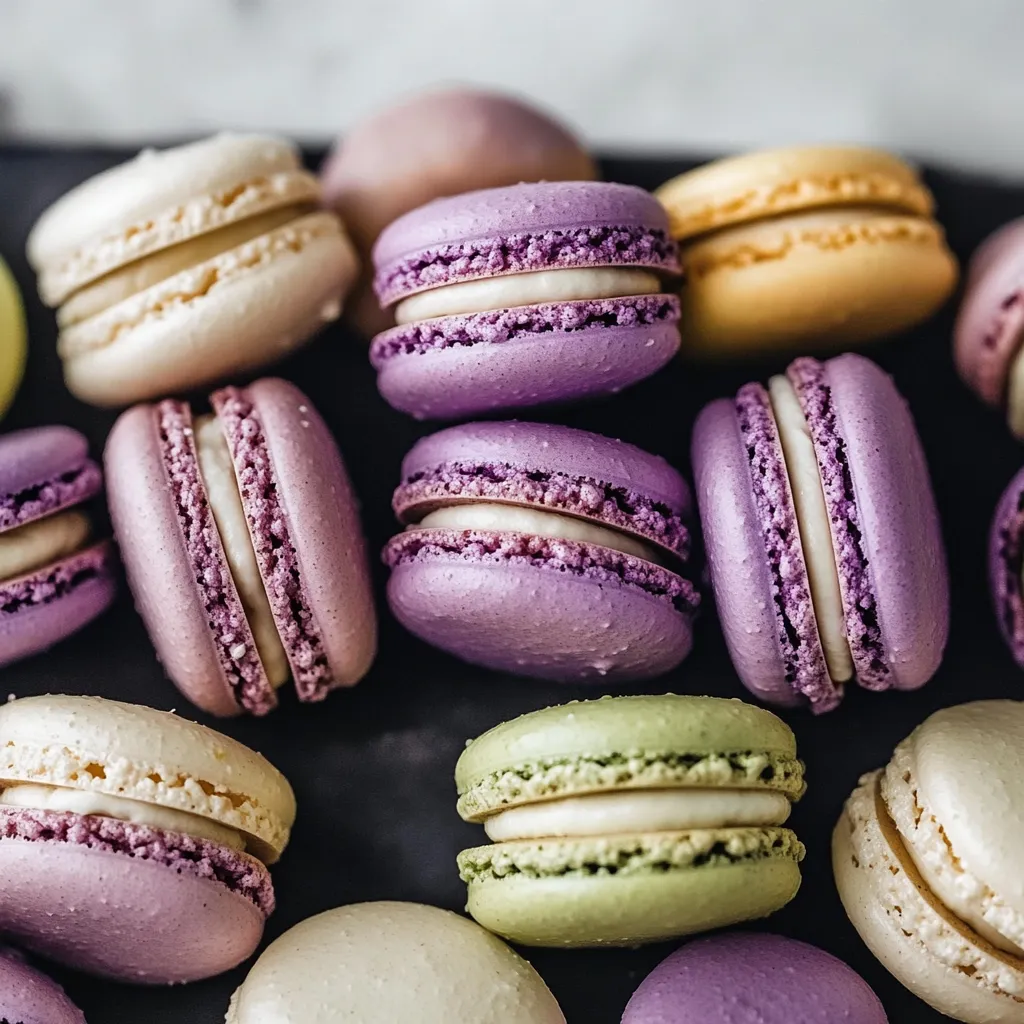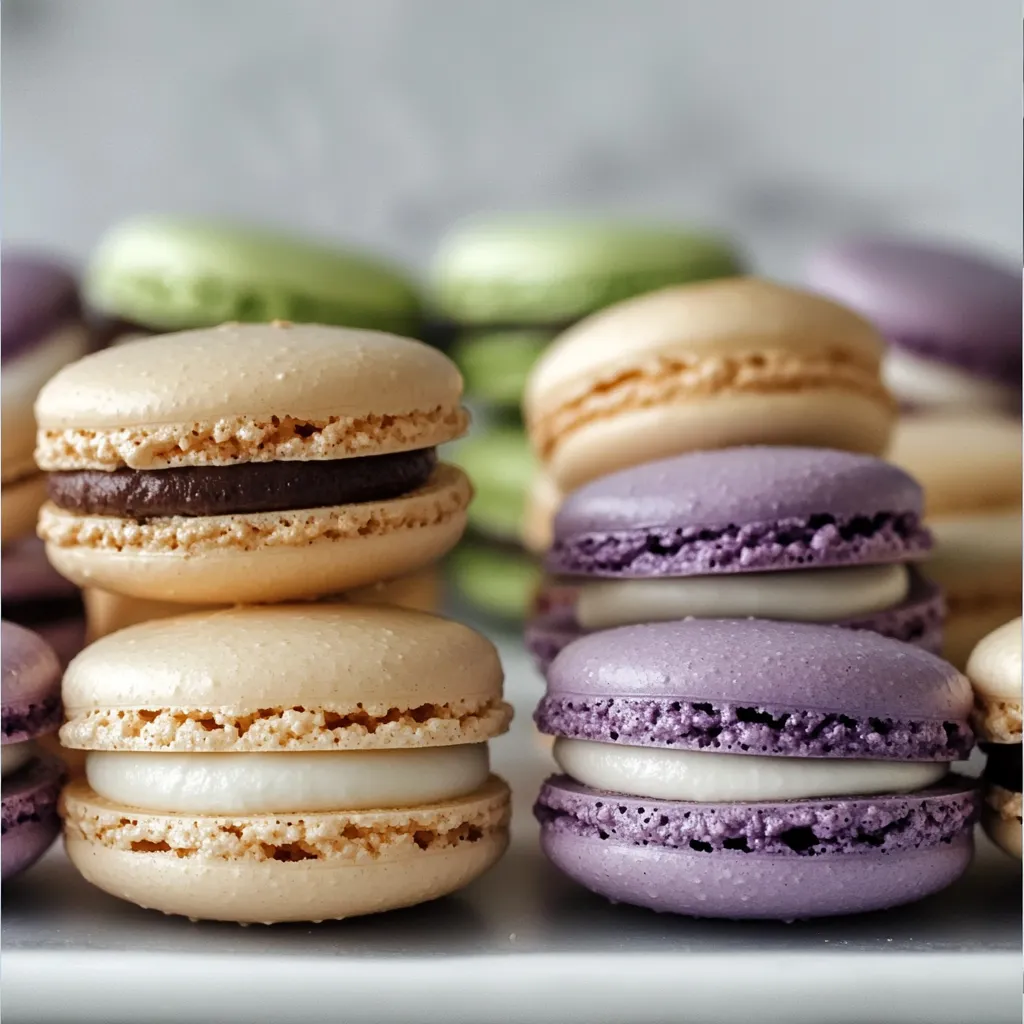 Pin
Pin
This hearty French macaron recipe has been my secret weapon for impressing guests at dinner parties and special occasions for years. The delicate, crisp shells with chewy interiors create that perfect texture contrast that makes macarons so irresistible.
I first attempted macarons during a rainy weekend when I was craving something from my favorite Parisian bakery. After several attempts and learning from each mistake, I finally mastered the technique. Now my kitchen transforms into a French patisserie whenever I make these delightful treats.
Ingredients
- Super fine almond flour: Provides the classic macaron texture and nutty flavor. Look for blanched almond flour for the smoothest results.
- Powdered sugar: Creates sweetness while helping with structure. Use pure confectioners sugar without cornstarch if possible.
- Egg whites: Form the foundation of the meringue. Room temperature eggs whip to greater volume than cold ones.
- Granulated sugar: Stabilizes the meringue. Fine sugar dissolves more easily during whipping.
- Liquid gel food coloring: Offers vibrant colors without affecting texture. Avoid regular liquid food coloring which adds too much moisture.
- Pure vanilla extract: Enhances flavor without overpowering. Use real extract rather than imitation for best results.
- Salt: Balances sweetness and enhances flavor. Even a small amount makes a big difference.
Step-by-Step Instructions
- Prepare Your Workspace:
- Line three large baking sheets with parchment paper for a clean release. Set up your piping bag with a large round tip and place it in a tall glass with the edges folded over to make filling easier later.
- Prepare Dry Ingredients:
- Sift the almond flour thoroughly to remove any large pieces that could disrupt the smooth texture. Mix with sifted powdered sugar to create the base that gives macarons their characteristic texture and flavor.
- Create Perfect Meringue:
- Start with an absolutely clean bowl wiped with vinegar to ensure no grease interferes with meringue formation. Whip room temperature egg whites with salt until foamy before gradually adding sugar in tiny increments to create a stable glossy meringue with stiff peaks.
- Add Color and Flavor:
- Incorporate food coloring and vanilla extract into the meringue until evenly distributed. The meringue should maintain its stiff peaks after adding these ingredients.
- Master the Macaronage:
- Fold the dry ingredients into the meringue in three additions using a specific folding technique that maintains air while achieving the right consistency. The perfect batter flows like lava and forms a figure eight that disappears within 20 seconds.
- Pipe Beautiful Shells:
- Hold your piping bag perpendicular to the baking sheet and apply even pressure to form uniform circles. Leave space between each macaron as they will spread slightly during the initial setting period.
- Rest and Develop Skin:
- Allow the piped macarons to rest until they form a dry skin on top that no longer feels sticky when lightly touched. This crucial step allows the distinctive feet to form during baking.
- Bake with Precision:
- Bake one tray at a time at exactly 315°F until the shells develop feet and no longer jiggle when gently pressed. Proper baking creates that crisp exterior while maintaining a chewy interior.
- Fill and Sandwich:
- Match similar sized shells and pipe filling onto one shell before gently pressing another on top. The filling should be generous enough to provide flavor but not so much that it squeezes out the sides.
 Pin
Pin
The most transformative moment in my macaron journey was discovering the importance of the macaronage technique. I spent hours watching French pastry chefs demonstrate the precise folding motion that creates that perfect consistency. That attention to detail completely changed my results from flat sad cookies to perfect professional looking treats.
The Secret to Perfect Feet
Those distinctive ruffled edges at the base of macarons known as feet are the hallmark of a well made macaron. The key to developing perfect feet lies in two crucial steps. First allowing the piped shells to rest until they form a dry skin which creates resistance during baking. Second maintaining the proper oven temperature which causes the trapped air to expand upward rather than outward. If your macarons lack feet you likely either skipped the resting period or your oven temperature was inaccurate.
Troubleshooting Common Issues
Hollow shells often result from overbeaten meringue or too high oven temperature. Try reducing your mixing time and checking your oven with a separate thermometer for accuracy. Cracked tops typically indicate insufficient resting time or too much moisture in your batter. Make sure your shells develop a completely dry surface before baking. Lopsided macarons usually happen when your oven has hot spots. Rotate your trays halfway through baking and consider using an oven thermometer to identify temperature variations.
Flavor Variations
Transform basic shells into exciting flavors by adding dry ingredients to your dry mixture. For chocolate macarons replace 2 tablespoons of almond flour with cocoa powder. Coffee lovers can add 1 teaspoon espresso powder to the dry ingredients. For fruity versions incorporate freeze dried fruit powder into your dry mix. The filling offers even more opportunity for creativity. Try chocolate ganache lemon curd or even savory options like herb infused buttercream. Remember that fillings should complement your shell flavor rather than compete with it.
Recipe Questions & Answers
- → What is the key to achieving perfect macaron shells?
Ensure your meringue is whipped to stiff peaks, properly sift almond flour, and mix the batter to a lava-like consistency. Rest the shells to form a skin before baking.
- → Can I use liquid food coloring for macarons?
Liquid food coloring is not recommended, as it can alter the batter's consistency. Use gel or powdered food coloring for best results.
- → Why do my macarons crack during baking?
Cracked shells often result from insufficient drying time before baking or an oven temperature that's too high. Allow shells to rest and form a skin, and ensure your oven is accurately set.
- → How long should macarons rest before baking?
Resting macarons for 30 to 60 minutes allows them to form a skin, which helps create the signature 'feet' during baking. Adjust resting time based on your kitchen's humidity.
- → What’s the best filling for macarons?
Vanilla buttercream is a classic, but you can experiment with ganache, fruit curds, or flavored buttercreams. Choose a filling that complements the delicate almond shells.